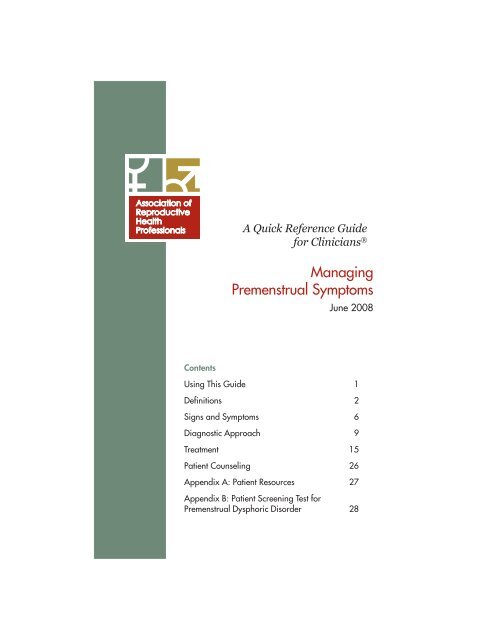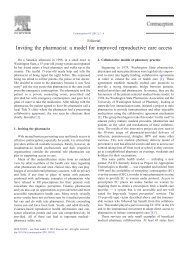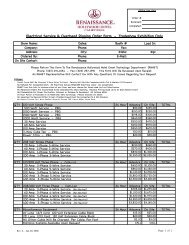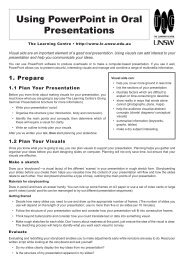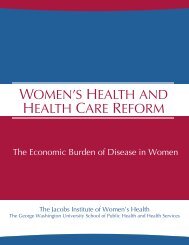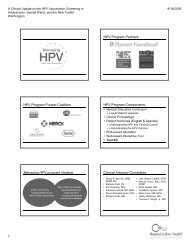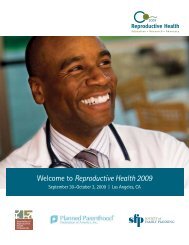Managing Premenstrual Symptoms - Association of Reproductive ...
Managing Premenstrual Symptoms - Association of Reproductive ...
Managing Premenstrual Symptoms - Association of Reproductive ...
Create successful ePaper yourself
Turn your PDF publications into a flip-book with our unique Google optimized e-Paper software.
A Quick Reference Guide<br />
for Clinicians ®<br />
<strong>Managing</strong><br />
<strong>Premenstrual</strong> <strong>Symptoms</strong><br />
June 2008<br />
Contents<br />
Using This Guide 1<br />
Definitions 2<br />
Signs and <strong>Symptoms</strong> 6<br />
Diagnostic Approach 9<br />
Treatment 15<br />
Patient Counseling 26<br />
Appendix A: Patient Resources 27<br />
Appendix B: Patient Screening Test for<br />
<strong>Premenstrual</strong> Dysphoric Disorder 28
Clinical Advisory Committee<br />
Andrew M. Kaunitz, MD<br />
Pr<strong>of</strong>essor and Associate Chairman<br />
Department <strong>of</strong> Obstetrics and Gynecology<br />
University <strong>of</strong> Florida College <strong>of</strong> Medicine<br />
Jacksonville, FL<br />
Emily L. Rowe, PharmD<br />
Clinical Pharmacist<br />
Children’s National Medical Center<br />
Washington, DC<br />
Sharon Myoji Schnare, RN, FNP, CNM, MSN, FAANP<br />
Clinical Instructor<br />
University <strong>of</strong> Washington Seattle School <strong>of</strong> Nursing<br />
Seattle, WA<br />
Contributing Staff<br />
Shama Alam, MScPH<br />
Education Associate<br />
Elizabeth S. Callihan<br />
Designer<br />
Beth Jordan, MD<br />
Medical Director<br />
Wayne C. Shields<br />
President and CEO<br />
Deborah J. Shuman<br />
Consulting Medical Writer/Editor<br />
Amy M. Swann, MA<br />
Director <strong>of</strong> Education<br />
This publication has been made possible by an<br />
educational grant from Bayer HealthCare Pharmaceuticals.<br />
<strong>Managing</strong> <strong>Premenstrual</strong> <strong>Symptoms</strong> June 2008
Using This Guide<br />
It is estimated that 75–85% <strong>of</strong> menstruating women experience<br />
some uncomfortable symptoms during the premenstrual phase <strong>of</strong><br />
their cycles. 1 Many women experience premenstrual symptoms that<br />
do not require specific treatment. In contrast, the symptoms <strong>of</strong><br />
premenstrual disorders interfere with normal functioning and have a<br />
significant negative effect on a woman’s quality <strong>of</strong> life.<br />
Despite increasing attention and awareness <strong>of</strong> premenstrual<br />
disorders, they are notoriously underrecognized. Many women<br />
delay seeking treatment and thus go undiagnosed for years. Yet the<br />
degree and prevalence <strong>of</strong> disability <strong>of</strong> premenstrual disorders equal<br />
that associated with many widely recognized conditions. 2 Overall,<br />
women with premenstrual disorders represent a largely uncared-for<br />
group for whom the evidence for conventional therapy is sparse<br />
and controversial. 3 Treatment options vary and produce overall<br />
response rates <strong>of</strong> less than 60%. 2<br />
The key to effective management <strong>of</strong> premenstrual disorders is time,<br />
patience, and knowledge <strong>of</strong> various treatments that have proven to<br />
be effective. This Quick Reference Guide for Clinicians ® has been<br />
designed to help health care providers to recognize premenstrual<br />
disorders and apply evidence-based management strategies. Also<br />
provided are clinical management alternatives and patient<br />
education information and resources.<br />
The practical steps outlined here will equip clinicians with the tools<br />
necessary to accurately and appropriately diagnose, treat, and<br />
counsel women dealing with premenstrual disorders. The<br />
information provided in this guide will help providers to reduce<br />
patients’ uncertainty regarding treatment options and to be more<br />
effective in <strong>of</strong>fering positive treatment strategies for women<br />
presenting with these symptoms.<br />
References<br />
1. Mishell DR Jr. <strong>Premenstrual</strong> disorders: epidemiology and disease burden. Am J<br />
Manag Care. 2005;11(16 Suppl):S473–479.<br />
2. Halbreich U, Borenstein J, Pearlstein T, Kahn LS. The prevalence, impairment,<br />
impact, and burden <strong>of</strong> premenstrual dysphoric disorder (PMS/PMDD).<br />
Psychoneuroendocrinology. 2003;28(Suppl 3):1–23.<br />
3. Domoney CL, Vashisht A, Studd JW. <strong>Premenstrual</strong> syndrome and the use <strong>of</strong><br />
alternative therapies. Ann N Y Acad Sci. 2003;997:330–340.<br />
1<br />
June 2008<br />
<strong>Managing</strong> <strong>Premenstrual</strong> <strong>Symptoms</strong>
Definitions<br />
Despite the familiarity <strong>of</strong> premenstrual symptoms to many women,<br />
there is no clear consensus on the definition <strong>of</strong> premenstrual<br />
disorders. Rather, these conditions make up a continuum <strong>of</strong><br />
disorders that are defined according to the nature and severity <strong>of</strong><br />
their symptoms. 1<br />
• <strong>Premenstrual</strong> molimina are the symptoms, sensations,<br />
feelings, and observations, such as bloating, headaches,<br />
nausea, ovulatory pain, and breast tenderness, that many<br />
women experience during the premenstrual phase <strong>of</strong> their<br />
cycles. These symptoms are minor, do not cause functional<br />
impairment, and are minimally distressing. They predict<br />
impending ovulation and subsequent menstruation. If they<br />
occur within 3 days <strong>of</strong> the onset <strong>of</strong> menses and do not<br />
represent a patient’s chief presenting complaint, they are<br />
considered to be a normal part <strong>of</strong> a woman’s menstrual cycle.<br />
• <strong>Premenstrual</strong> syndrome (PMS) is a term coined in 1931 to<br />
describe a constellation <strong>of</strong> physical and emotional symptoms<br />
unique to women during their childbearing years. 2<br />
<strong>Premenstrual</strong> symptoms in general are <strong>of</strong>ten described or<br />
referred to as PMS. 3 Accepted definitions <strong>of</strong> the disorder<br />
require that symptoms must occur only during the luteal phase<br />
to be considered PMS.<br />
• <strong>Premenstrual</strong> dysphoric disorder (PMDD) is defined by<br />
diagnostic criteria outlined in the Diagnostic and Statistical<br />
Manual <strong>of</strong> Mental Disorders (DSM). 4 Both PMS and PMDD<br />
produce symptoms that are associated with the ovarian cycle<br />
<strong>of</strong> a woman <strong>of</strong> reproductive age. These disorders represent<br />
abnormal responses to normal endocrine changes associated<br />
with ovulation. The symptoms <strong>of</strong> these disorders may continue<br />
to occur during a woman’s menstrual cycle until she reaches<br />
2<br />
The National Library <strong>of</strong> Medicine’s Medical Subject Headings<br />
(MeSH) terminology defines PMS as follows: “A combination <strong>of</strong><br />
distressing physical, psychologic, or behavioral changes that<br />
occur during the luteal phase <strong>of</strong> the menstrual cycle. <strong>Symptoms</strong> <strong>of</strong><br />
PMS are diverse (such as pain, water retention, anxiety, cravings,<br />
and depression) and they diminish markedly 2–3 days after the<br />
initiation <strong>of</strong> menses.”<br />
<strong>Managing</strong> <strong>Premenstrual</strong> <strong>Symptoms</strong> June 2008
menopause. (See “Signs and <strong>Symptoms</strong>” on page 6 for the<br />
DSM criteria required for a diagnosis <strong>of</strong> PMDD.)<br />
In contrast to psychiatrists and other mental health pr<strong>of</strong>essionals,<br />
most obstetrician/gynecologists (ob/gyns) and other women’s<br />
health care providers do not distinguish between PMS and PMDD.<br />
The approaches to diagnosis and management <strong>of</strong> these disorders<br />
are therefore addressed together in this guide.<br />
Epidemiology <strong>of</strong> <strong>Premenstrual</strong> Disorders: Fast Facts<br />
• An estimated 43–55 million women experience some<br />
uncomfortable symptoms during the premenstrual phase <strong>of</strong><br />
their cycles. 5<br />
• The lifetime prevalence <strong>of</strong> PMS is estimated to be<br />
approximately 13–18% <strong>of</strong> women <strong>of</strong> reproductive age. 6<br />
• PMS affects women throughout the reproductive years:<br />
– Occurs most <strong>of</strong>ten in women in their late 20s to early 40s. 7<br />
– Also significant in adolescents. 8<br />
– Average age <strong>of</strong> onset is 26 years. 9<br />
• PMS occurs more <strong>of</strong>ten in women who: 7<br />
– Have had at least one child.<br />
– Have a family history <strong>of</strong> depression.<br />
– Have a history <strong>of</strong> postpartum depression or mood disorder.<br />
• PMS symptoms tend to worsen over the course <strong>of</strong> the<br />
reproductive years. 9<br />
• Approximately 12–25 million women have premenstrual<br />
symptoms that interfere with their daily lives: 5<br />
– About 20–40% <strong>of</strong> women who have physical changes<br />
with menstruation experience symptoms <strong>of</strong> PMS. 10,11<br />
– About 3–9% <strong>of</strong> women <strong>of</strong> reproductive age meet the<br />
3<br />
criteria for PMDD. 6<br />
– Approximately 2–5 million women have severe<br />
PMDD symptoms. 12,13<br />
June 2008<br />
<strong>Managing</strong> <strong>Premenstrual</strong> <strong>Symptoms</strong>
Etiology <strong>of</strong> <strong>Premenstrual</strong> Disorders 14,15<br />
Although the etiology <strong>of</strong> premenstrual disorders is unclear, hypotheses<br />
abound and include the following:<br />
• Allergies<br />
• Catecholamine alterations<br />
• Endorphin withdrawal<br />
• Fluid retention<br />
• Hormonal alterations (high estrogen, falling estrogen,<br />
changes in estrogen-progesterone ratio, excess prolactin)<br />
• Hypoglycemia<br />
• Increased adrenal activity<br />
• Increased aldosterone activity<br />
• Increased renin-angiotensin activity<br />
• Nutritional deficiencies<br />
• Prostaglandin impact<br />
• Psychological or psychogenic effects<br />
Additionally, there may be a concomitant overlay <strong>of</strong> other disorders<br />
such as stress, posttraumatic stress, anxiety disorder, and depression.<br />
References<br />
4<br />
1. Yonkers KA, Pearlstein T, Rosenheck RA. <strong>Premenstrual</strong> disorders: bridging<br />
research and clinical reality. Arch Womens Ment Health. 2003;6(4):287–92.<br />
2. Moline ML, Zendell SM. Evaluating and managing premenstrual syndrome.<br />
Medscape Womens Health 2000;5(2):1. Available at www.medscape.com/<br />
viewarticle/408913. Accessed March 25, 2008.<br />
3. Steiner M. <strong>Premenstrual</strong> syndrome and premenstrual dysphoric disorder:<br />
guidelines for management. J Psychiatry Neurosci. 2000;25(5):459–68.<br />
4. American Psychiatric <strong>Association</strong>. Diagnostic and Statistical Manual <strong>of</strong> Mental<br />
Disorders, 4th ed., Text Revision. Washington, DC: American Psychiatric<br />
<strong>Association</strong>, 2000.<br />
5. Mishell DR Jr. <strong>Premenstrual</strong> disorders: epidemiology and disease burden. Am J<br />
Manag Care. 2005;11(16 Suppl):S473–9.<br />
6. Halbreich U, Borenstein J, Pearlstein T, Kahn LS. The prevalence, impairment,<br />
impact, and burden <strong>of</strong> premenstrual dysphoric disorder (PMS/PMDD).<br />
Psychoneuroendocrinology. 2003;28(Suppl 3):1–23.<br />
<strong>Managing</strong> <strong>Premenstrual</strong> <strong>Symptoms</strong> June 2008
7. U.S. Department <strong>of</strong> Health and Human Services, National Women’s Health<br />
Information Center. womenshealth.gov. <strong>Premenstrual</strong> Syndrome. Available at<br />
www.4woman.gov/faq/pms.htm. Accessed April 7, 2008.<br />
8. Rapkin AJ, Tsao JCI, Turk N, Anderson M, Zeltzer LK. Relationships among selfrated<br />
Tanner staging, hormones, and psychosocial factors in health female<br />
adolescents. J Pediatr Adolesc Gynecol. 2006;19:181–7.<br />
9. Steiner M. <strong>Premenstrual</strong> syndrome and premenstrual dysphoric disorder:<br />
guidelines for management. J Psychiatry Neurosci. 2000;25(5):459–68.<br />
10. American College <strong>of</strong> Obstetricians and Gynecologists. <strong>Premenstrual</strong> Syndrome.<br />
ACOG Practice Bulletin No. 15. Washington, DC: American College <strong>of</strong><br />
Obstetricians and Gynecologists, 2000.<br />
11. Bhatia SC, Bhatia SK. Diagnosis and treatment <strong>of</strong> premenstrual dysphoric<br />
disorder. Am Fam Physician. 2002;66(7):1239–48.<br />
12. Ginsberg KA, Dinsay R. In: Ransom SB, ed. Practical Strategies in Obstetrics and<br />
Gynecology. Philadelphia: W.B. Saunders; 2000:684–9.<br />
13. U.S. Census Bureau. Annual estimates <strong>of</strong> the population by sex and five-year age<br />
groups for the United States: April 1, 2000 to July 1, 2004. U.S. Census Bureau,<br />
Population Division.<br />
14. Maxson WS, Rosenwaks Z. In: Copeland LJ, Jarrell JF, eds. Textbook <strong>of</strong><br />
Gynecology, 2nd ed. Philadelphia: W.B. Saunders; 2000:513–4.<br />
15. Sper<strong>of</strong>f L, Glass RH, Kase NG, eds. Menstrual Disorders in Gynecologic<br />
Endocrinology and Infertility, 6th Ed. Philadelphia, PA: Lippincott Williams &<br />
Wilkins, 1999:557–74.<br />
5<br />
June 2008<br />
<strong>Managing</strong> <strong>Premenstrual</strong> <strong>Symptoms</strong>
Signs and <strong>Symptoms</strong><br />
<strong>Symptoms</strong> <strong>of</strong> both PMS and PMDD occur during the luteal phase <strong>of</strong><br />
the menstrual cycle (days 14–28 in a 28-day cycle) and notably<br />
subside within 2–3 days after menses begins. Some women<br />
experience positive symptoms, such as a sense <strong>of</strong> well-being, in the<br />
luteal phase <strong>of</strong> their cycles. More <strong>of</strong>ten, negative symptoms<br />
undermine a woman’s ability to function across multiple settings,<br />
including work, school, and home. 1<br />
<strong>Premenstrual</strong> Syndrome<br />
Although more than 200 symptoms have been associated with<br />
PMS, common symptoms include the following: 2<br />
Physiological<br />
symptoms:<br />
Abdominal bloating<br />
Back pain<br />
Breast pain,<br />
tenderness, and/or<br />
swelling<br />
Headache<br />
Muscle aches<br />
Weight gain<br />
Behavioral<br />
symptoms:<br />
Aggression<br />
Changes in sexual<br />
interest<br />
Dizziness<br />
Fatigue<br />
Food cravings or<br />
overeating<br />
Insomnia<br />
Psychological<br />
symptoms:<br />
Anger<br />
Anxiety<br />
Confusion<br />
Crying and tearfulness<br />
Decreased self-esteem<br />
Depressed mood<br />
Difficulty concentrating<br />
Forgetfulness<br />
Irritability<br />
Loneliness<br />
Mood swings<br />
Restlessness<br />
Tension<br />
6<br />
<strong>Managing</strong> <strong>Premenstrual</strong> <strong>Symptoms</strong> June 2008
The American College <strong>of</strong> Obstetricians and Gynecologists (ACOG) has<br />
developed the following diagnostic criteria for the diagnosis <strong>of</strong> PMS: 3<br />
ACOG Diagnostic Criteria for PMS<br />
Patient reports at least one <strong>of</strong> each <strong>of</strong> the following affective and<br />
somatic symptoms during the 5 days before menses. <strong>Symptoms</strong> must<br />
appear in three consecutive menstrual cycles:<br />
Affective:<br />
fective: Depression, angry outbursts, irritability, anxiety, confusion,<br />
social withdrawal<br />
Somatic: Breast tenderness, abdominal bloating, headache, swelling<br />
<strong>of</strong> extremities<br />
<strong>Symptoms</strong> must also meet the following criteria:<br />
• Be relieved within 4 days <strong>of</strong> the onset <strong>of</strong> menses, without<br />
recurrence until at least cycle day 13<br />
• Be present in the absence <strong>of</strong> any pharmacologic therapy,<br />
hormone ingestion, or drug or alcohol use<br />
• Be causing identifiable dysfunction in social or economic<br />
performance<br />
• Occur reproducibly during two cycles <strong>of</strong> prospective recording<br />
<strong>Premenstrual</strong> Dysphoric Disorder<br />
<strong>Reproductive</strong> health pr<strong>of</strong>essionals generally view PMDD as a particularly<br />
severe form <strong>of</strong> PMS with pronounced psychological and emotional<br />
symptoms. 4 Unlike mental health pr<strong>of</strong>essionals, most obstetrician/<br />
gynecologists (ob/gyns) do not distinguish between PMS and PMDD. The<br />
DSM criteria for the diagnosis <strong>of</strong> PMDD is listed in the chart on page 8. 5<br />
References<br />
1. Malone DC. <strong>Managing</strong> the spectrum <strong>of</strong> premenstrual symptoms. Am J Manag<br />
Care. 2005:11(16):S471–2.<br />
2. Dickerson LM, Mazyck PJ, Hunter MH. <strong>Premenstrual</strong> syndrome. Am Fam<br />
Physician. 2003;67(8):1743–52.<br />
3. American College <strong>of</strong> Obstetricians and Gynecologists. <strong>Premenstrual</strong> Syndrome.<br />
ACOG Practice Bulletin No. 15. Washington, DC: American College <strong>of</strong><br />
Obstetricians and Gynecologists, 2000.<br />
4. Rapkin A. A review <strong>of</strong> treatment <strong>of</strong> premenstrual syndrome and premenstrual<br />
dysphoric disorder. Psychoneuroendocrinology. 2003;28(Suppl 3):39–53.<br />
5. American Psychiatric <strong>Association</strong>. Diagnostic and Statistical Manual <strong>of</strong> Mental Disorders,<br />
4th ed., Text Revision. Washington, DC: American Psychiatric <strong>Association</strong>, 2000.<br />
7<br />
June 2008<br />
<strong>Managing</strong> <strong>Premenstrual</strong> <strong>Symptoms</strong>
DSM Criteria for <strong>Premenstrual</strong> Dysphoric Disorder 5<br />
8<br />
A. In most menstrual cycles during the past year, five (or more)<br />
<strong>of</strong> the following symptoms were present for most <strong>of</strong> the time<br />
during the last week <strong>of</strong> the luteal phase, began to remit<br />
within a few days after the onset <strong>of</strong> the follicular phase, and<br />
were absent in the week postmenses, with at least one <strong>of</strong><br />
the symptoms being 1, 2, 3, or 4:<br />
1. Markedly depressed mood, feelings <strong>of</strong> hopelessness, or<br />
self-deprecating thoughts<br />
2. Marked anxiety, tension, feelings <strong>of</strong> being “keyed up” or<br />
“on the edge”<br />
3. Marked affective lability (e.g., feeling suddenly sad or<br />
tearful or increased sensitivity to rejection)<br />
4. Persistent and marked anger or irritability or increased<br />
interpersonal conflicts<br />
5. Decreased interest in usual activities (e.g., work, school,<br />
friends, hobbies)<br />
6. Subjective sense <strong>of</strong> difficulty in concentrating<br />
7. Lethargy, easy fatigability, or marked lack <strong>of</strong> energy<br />
8. Marked change in appetite, overeating, or specific food<br />
cravings<br />
9. Hypersomnia or insomnia<br />
10. A subjective sense <strong>of</strong> being overwhelmed or out <strong>of</strong> control<br />
11. Other physical symptoms, such as breast tenderness or<br />
swelling, headaches, joint or muscle pain, a sensation <strong>of</strong><br />
“bloating,” weight gain<br />
B. The disturbance markedly interferes with work or school or<br />
with usual social activities and relationships with others<br />
(e.g., avoidance <strong>of</strong> social activities, decreased productivity<br />
and efficiency at work or school)<br />
C. The disturbance is not merely an exacerbation <strong>of</strong> the symptoms<br />
<strong>of</strong> another disorder, such as Major Depressive Disorder, Panic<br />
Disorder, Dysthymic Disorder, or a Personality Disorder<br />
(although it may be superimposed on any <strong>of</strong> these disorders).<br />
D. Criteria A, B, and C must be confirmed by prospective daily<br />
ratings during at least two consecutive somatic cycles. (The<br />
diagnosis may be made provisionally prior to this confirmation.)<br />
<strong>Managing</strong> <strong>Premenstrual</strong> <strong>Symptoms</strong> June 2008
Diagnostic Approach<br />
Changing and inconsistent diagnostic criteria for premenstrual<br />
disorders over the past few decades can make the diagnosis <strong>of</strong><br />
PMS/PMDD a challenge. Patients should be counseled that it may<br />
take some time to complete the diagnostic process. They should be<br />
assured that various treatments can be tried until an effective and<br />
suitable approach is found. 1 Immediate measures should be<br />
recommended to the patient to ameliorate symptoms while a<br />
definitive diagnosis is being sought. These include lifestyle<br />
modifications such as stress reduction, exercise, dietary changes,<br />
supplements, and psychosocial support. 2, 3<br />
The Multiple-Visit Diagnostic Process<br />
Diagnosis is best approached as a multiple-visit process. 4 In<br />
general, the diagnosis <strong>of</strong> PMS is one <strong>of</strong> exclusion, and it is<br />
important to differentiate it from other conditions sharing similar<br />
characteristics. Almost two-thirds <strong>of</strong> women with PMS symptoms<br />
have a psychiatric disorder as well, thus complicating the<br />
evaluation <strong>of</strong> premenstrual symptoms.<br />
To meet the criteria for PMS or PMDD, symptoms must:<br />
• Occur in the luteal phase <strong>of</strong> the menstrual cycle and resolve<br />
within a few days <strong>of</strong> the start <strong>of</strong> menstruation<br />
• Create problems or impairment for the patient<br />
• Not be better explained by another diagnosis<br />
Obtaining prospective charting information for a 2-month period<br />
represents the best way to diagnose both PMS and PMDD. 4 A<br />
symptom chart such as that shown in Figure 1 on pages 14 and 15<br />
is provided to the patient, who marks the occurrence and severity <strong>of</strong><br />
symptoms on each day <strong>of</strong> at least two consecutive months. The<br />
clinician can then assess the pattern <strong>of</strong> symptoms in relation to the<br />
entire cycle. A clear pattern <strong>of</strong> symptoms that occur throughout the<br />
entire luteal phase and stop within 3 days <strong>of</strong> the onset <strong>of</strong> menses is<br />
diagnostic <strong>of</strong> PMS.<br />
9<br />
June 2008<br />
<strong>Managing</strong> <strong>Premenstrual</strong> <strong>Symptoms</strong>
Table 1. Differential Diagnosis <strong>of</strong> <strong>Premenstrual</strong> Disorders 4-6<br />
Angina<br />
Asthma<br />
Chronic fatigue syndrome<br />
Cyclic mastalgia<br />
Diabetes<br />
Endometriosis<br />
Genital herpes<br />
Irritable bowel syndrome<br />
Menstrual-associated migraine<br />
<strong>Premenstrual</strong> molimina<br />
Psychiatric disorders:<br />
• Anxiety<br />
• Bipolar disorder<br />
• Depression<br />
• Personality disorder<br />
• Posttraumatic stress disorder<br />
Raynaud phenomenon<br />
Seizure disorders<br />
Substance use disorders<br />
Thyroid disorders<br />
10<br />
Visit 1<br />
During the first visit, a history <strong>of</strong> menstrual symptoms and the<br />
presenting complaint should be elicited from the patient and a<br />
differential diagnosis developed (Table 1).<br />
• A complete medical history should include menstrual history,<br />
history <strong>of</strong> gynecologic conditions (e.g., endometriosis,<br />
surgery), and obstetric history.<br />
<strong>Managing</strong> <strong>Premenstrual</strong> <strong>Symptoms</strong> June 2008
• Treatment or psychotherapy for mental health problems,<br />
particularly mood disorders (anxiety, depression), should also<br />
be recorded and a psychiatric or psychotherapeutic referral<br />
considered as warranted.<br />
• Laboratory tests should be conducted to aid in the<br />
differential diagnosis: 6<br />
– Chemistry pr<strong>of</strong>ile to assess electrolyte disturbances<br />
– Complete blood cell count to rule out anemia<br />
– Thyroid-stimulating hormone level to rule out thyroid<br />
disorders<br />
The affective symptoms <strong>of</strong> PMDD in particular may closely resemble<br />
those <strong>of</strong> premenstrual exacerbations <strong>of</strong> psychiatric disorders,<br />
especially depression and anxiety. If the patient reports no<br />
symptom-free period, it may be appropriate to refer her to a<br />
mental health pr<strong>of</strong>essional. 6<br />
At the end <strong>of</strong> the first visit, the patient should be instructed in the use<br />
<strong>of</strong> a daily symptom rating chart (see “The Charting Interval” and<br />
Figure 1) and counseled about lifestyle changes, such as diet,<br />
exercise, and sleep habits that may ameliorate some symptoms until<br />
the next visit. A follow-up visit should be scheduled for 6–8 weeks.<br />
The Charting Interval<br />
In the interim between the first and second visits, the patient should<br />
keep a daily record <strong>of</strong> her symptoms and try the nonpharmacologic<br />
measures decided upon at the first visit.<br />
Prospective charting <strong>of</strong> symptoms has been found to be an effective<br />
and accurate approach to the diagnosis <strong>of</strong> premenstrual disorders<br />
for a variety <strong>of</strong> reasons:<br />
• DSM-IV criteria require prospective information for a diagnosis<br />
<strong>of</strong> PMDD. More than half <strong>of</strong> women who present with “severe<br />
premenstrual symptoms” are found not to have a luteal-phase<br />
pattern according to prospective charting. 4<br />
• Self-help strategies such as lifestyle changes can be initiated<br />
and evaluated during the charting period. Deferring<br />
pharmacologic treatment during this interval allows these<br />
measures to be objectively evaluated.<br />
11<br />
June 2008<br />
<strong>Managing</strong> <strong>Premenstrual</strong> <strong>Symptoms</strong>
• Many women benefit from charting by gaining the ability to<br />
see their individual menstrual patterns and plan their activities<br />
around the most difficult phases <strong>of</strong> their cycles.<br />
The Second Visit<br />
At the second visit, the laboratory test results and the patient’s daily<br />
charting should be reviewed. A diagnosis <strong>of</strong> PMS or PMDD<br />
requires the symptoms to occur throughout the luteal phase <strong>of</strong> the<br />
menstrual cycle and to abate with the onset <strong>of</strong> menses.<br />
Most ob/gyns do not distinguish between PMS and PMDD. Patients<br />
whose mental and emotional symptoms are not responsive to the<br />
treatment approaches described here should be referred for<br />
psychiatric evaluation.<br />
References<br />
1. Rapkin AJ. New treatment approaches for premenstrual disorders. Am J Manag<br />
Care. 2005;11(16 Suppl):S480–91.<br />
2. American College <strong>of</strong> Obstetricians and Gynecologists. <strong>Premenstrual</strong> Syndrome.<br />
ACOG Practice Bulletin No. 15. Washington, DC: American College <strong>of</strong><br />
Obstetricians and Gynecologists, 2000.<br />
3. Dickerson LM, Mazyck PJ, Hunter MH. <strong>Premenstrual</strong> syndrome. Am Fam<br />
Physician. 2003;67(8):1743–52.<br />
4. Johnson SR. <strong>Premenstrual</strong> syndrome, premenstrual dysphoric disorder, and<br />
beyond: a clinical primer for practitioners. Obstet Gynecol. 2004;104(4):845–59.<br />
5. Guille C, Spencer S, Cavus I, Epperson CN. The role <strong>of</strong> sex steroids in catamenial<br />
epilepsy and premenstrual dysphoric disorder: implications for diagnosis and<br />
treatment. Epilepsy Behav. 2008; Mar 16 [Epub ahead <strong>of</strong> print].<br />
6. Kaur G, Gonsalves L, Thaker HL. <strong>Premenstrual</strong> dysphoric disorder: a review for<br />
the treating practitioner. Cleve Clin Med. 2004;71(4):303–21 passim.<br />
12<br />
<strong>Managing</strong> <strong>Premenstrual</strong> <strong>Symptoms</strong> June 2008
Treatment<br />
More than 80 different therapies have been suggested for the<br />
treatment <strong>of</strong> PMS/PMDD, resulting in much conflicting information<br />
and many unwarranted claims <strong>of</strong> effectiveness. No single<br />
intervention is effective for all women, and there is a substantial<br />
placebo response with many therapies. 1 It may take time and<br />
several attempts to determine the safest and most effective treatment<br />
for an individual patient.<br />
Treatment <strong>of</strong> PMS/PMDD is best approached in a stepwise fashion,<br />
beginning with lifestyle modifications and progressing to nutritional<br />
supplementation, nonpharmacologic therapy, and nonprescription and<br />
prescription medications. Conservative treatment has proved beneficial<br />
in many women and should be considered first-line therapy in women<br />
with mild symptoms and adjunctive therapy in all others.<br />
Table 2 on page 16 shows a hierarchical approach to the treatment<br />
<strong>of</strong> PMS/PMDD that matches the aggressiveness <strong>of</strong> the approach to<br />
the severity <strong>of</strong> symptoms. Selection <strong>of</strong> therapy can also be matched<br />
to the nature <strong>of</strong> the symptoms. For instance, women with a PMS<br />
diagnosis presenting with bloating and breast tenderness as her<br />
key symptoms (Level 2) may be prescribed spironolactone, if there<br />
are no contraindications, to minimize this specific symptom.<br />
Treatment must be individualized and <strong>of</strong>ten requires a combination<br />
<strong>of</strong> approaches. Long-term treatment <strong>of</strong> PMS/PMDD is typically<br />
required, as evidence indicates that symptoms return when<br />
treatment is discontinued. 3<br />
Lifestyle Changes<br />
Treatment <strong>of</strong> mild premenstrual disorders begins with 2–3 months<br />
<strong>of</strong> lifestyle changes during the same time the woman is charting her<br />
symptoms. Based on medical history, the modifications listed in<br />
Table 2 can be suggested.<br />
Pharmacologic Treatment<br />
Selective Serotonin Reuptake Inhibitors<br />
13<br />
Selective serotonin reuptake inhibitors (SSRIs) should be considered<br />
first-line therapy for the pharmacologic treatment <strong>of</strong> severe<br />
premenstrual symptoms. 22 An estimated 60% <strong>of</strong> women respond to<br />
June 2008<br />
<strong>Managing</strong> <strong>Premenstrual</strong> <strong>Symptoms</strong>
Figure 1: Menstrual <strong>Symptoms</strong> Chart<br />
List the symptoms you have in the left column. Circle the dates <strong>of</strong> your menstrual period.<br />
Fill in the boxes on the days your symptoms occur. Indicate severity by filling in the boxes as shown: Mild<br />
Month:<br />
Day <strong>of</strong> the month<br />
<strong>Symptoms</strong><br />
1 2 3 4 5 6 7 8 9 10 11 12 13 14<br />
Month:<br />
<strong>Symptoms</strong><br />
1 2 3 4 5 6 7 8 9 10 11 12 13 14<br />
Day <strong>of</strong> the month<br />
Month:<br />
<strong>Symptoms</strong><br />
1 2 3 4 5 6 7 8 9 10 11 12 13 14<br />
Day <strong>of</strong> the month<br />
This chart may be downloaded at www.arhp.org/menstru
Figure 1: Menstrual <strong>Symptoms</strong> Chart<br />
e dates <strong>of</strong> your menstrual period.<br />
icate severity by filling in the boxes as shown: Mild Moderate Severe<br />
<br />
Day <strong>of</strong> the month<br />
14 15 16 17 18 19 20 21 22 23 24 25 26 27 27 29 30 31<br />
Day <strong>of</strong> the month<br />
14 15 16 17 18 19 20 21 22 23 24 25 26 27 27 29 30 31<br />
Day <strong>of</strong> the month<br />
14 15 16 17 18 19 20 21 22 23 24 25 26 27 27 29 30 31<br />
ay be downloaded at www.arhp.org/menstrualsymptomschart
Table 2. Hierarchical Approach to the Treatment <strong>of</strong> PMS and PMDD 2<br />
Move to the next level if the chosen approach is ineffective for two<br />
to four cycles.<br />
Level 1. PMS, mild to moderate:<br />
• Lifestyle: Aerobic exercise, nutritional changes (reduction <strong>of</strong><br />
caffeine, salt, alcohol; increase in complex carbohydrates)<br />
• Nonprescription drugs:<br />
– Calcium, 1,000 g or magnesium 400 g, once daily<br />
– Chaste tree extract (Vitex agnus-castus) 30-40 mg daily<br />
• Relaxation therapy<br />
• Cognitive behavioral therapy<br />
Level 2. PMS with physical problems predominating:<br />
• Spironolactone, 25 mg daily, for breast tenderness<br />
and bloating<br />
• OCs (regular or long cycle) or MPA for breast and<br />
abdominal pain<br />
• NSAIDs during the luteal phase<br />
Level 3. PMS or PMDD with mood symptoms predominating:<br />
• SSRIs* on symptom days only<br />
• Continuous SSRIs*<br />
• Buspirone during the luteal phase<br />
Level 4. PMDD not responsive to therapy for Levels 1–3:<br />
• Continuous high-dose progestin (e.g., oral MPA, 20–30 mg<br />
daily; DMPA, 150 mg every 3 months; Yaz ® )<br />
• GnRH (usual dose) with add-back estrogen/progestin if<br />
continued beyond 6 months<br />
16<br />
*<br />
If initial SSRI is ineffective or not tolerated, try at least two additional types <strong>of</strong> SSRIs<br />
(including venlafaxine) before abandoning this type <strong>of</strong> agent.<br />
GnRH = gonadotropin-releasing hormone; MPA = medroxyprogesterone acetate;<br />
DMPA = depo-medroxyprogesterone acetate; NSAID = nonsteroidal anti-inflammatory<br />
drug; OC = oral contraceptive; PMS = premenstrual syndrome; PMDD = premenstrual<br />
dysphoric disorder; SSRI = selective serotonin reuptake inhibitor.<br />
<strong>Managing</strong> <strong>Premenstrual</strong> <strong>Symptoms</strong> June 2008
Dietary<br />
Table 3. Lifestyle Modifications for Mild PMS 4 – 21<br />
• Eat frequent and smaller portions <strong>of</strong> foods high in complex<br />
carbohydrates<br />
• Reduce:<br />
– Salt<br />
– Sugar<br />
– Caffeine<br />
– Dairy products (or take lactase enzymes)<br />
– Alcohol<br />
Nutritional Supplementation<br />
• Vitamin B 6<br />
, up to 100 mg per day (limited benefit)<br />
• Vitamin E, up to 600 IU per day (limited benefit)<br />
• Calcium carbonate, 1,200 mg per day, with vitamin D,<br />
400 IU per day for absorption, in divided doses *<br />
• Magnesium, up to 500 mg per day<br />
Behavioral<br />
• Patient education/counseling about PMS/PMDD (See<br />
Appendix A for patient resources.)<br />
• Regular aerobic exercise (20–30 minutes, 3 times per week)<br />
• Yoga<br />
• Relaxation and stress management<br />
• Anger management<br />
• Self-help support groups<br />
• Individual and couples therapy<br />
• Cognitive-behavioral therapy *<br />
• Smoking cessation<br />
• Regular sleep<br />
• Light therapy<br />
Nonprescription Medications<br />
• NSAIDs (naproxen, mefenamic acid, ibupr<strong>of</strong>en, etc.) in<br />
doses commonly used in the treatment <strong>of</strong> menstrual cramps<br />
17<br />
*<br />
Evidence based<br />
June 2008<br />
<strong>Managing</strong> <strong>Premenstrual</strong> <strong>Symptoms</strong>
this class <strong>of</strong> drugs. 15 SSRIs have been shown to be effective for both<br />
PMS and PMDD 9 and to be equally efficacious for the treatment <strong>of</strong><br />
physical, behavioral, and psychological symptoms. 23<br />
Safety and Side Effects<br />
The long-term safety <strong>of</strong> SSRIs has been demonstrated based on<br />
their widespread use in treating depression. 1 More recently, this<br />
class <strong>of</strong> drugs has had labeling changes to reflect the increased risk<br />
<strong>of</strong> suicidal thinking and behavior in young adults. 22,23<br />
Side effects <strong>of</strong> SSRIs include the following:<br />
18<br />
• Anxiety<br />
• Sedation<br />
• Insomnia<br />
• Decreased libido<br />
• Gastrointestinal disturbances (including nausea and indigestion)<br />
• Fatigue<br />
• Headache<br />
• Dry mouth<br />
• Dizziness<br />
• Tremor<br />
• Sweating<br />
• Weight gain<br />
These side effects are generally manageable and may be reduced<br />
or eliminated by dose modification and use during the luteal phase<br />
only. There is no addictive potential and no tolerance with extended<br />
use <strong>of</strong> SSRIs. SSRIs are classified as Pregnancy Category C.<br />
Orgasmic dysfunction (normal libido and arousal with delayed or<br />
absent orgasm) is the most problematic side effect <strong>of</strong> this class <strong>of</strong><br />
drugs, reported in up to 80% <strong>of</strong> patients taking SSRIs continuously<br />
and for long duration. 24 Sexual dysfunction can be managed by<br />
the following: 3<br />
• Taking a watch and wait approach, as it may resolve on its own<br />
• Reducing the dose<br />
<strong>Managing</strong> <strong>Premenstrual</strong> <strong>Symptoms</strong> June 2008
• Taking drug holidays<br />
• Substituting another SSRI agent<br />
• Augmenting treatment with various agents (such as bupropion)<br />
Women who have been counseled to anticipate that it may be more<br />
difficult to achieve orgasm when using SSRIs and other<br />
serotonergic agents may be best equipped to manage this common<br />
side effect, <strong>of</strong>ten through communication with their partner. Many<br />
women experiencing relief <strong>of</strong> their PMS/PMDD symptoms may be<br />
so pleased with their improvement on SSRIs that they are willing to<br />
tolerate or adapt to the sexual dysfunction associated with use <strong>of</strong><br />
this class <strong>of</strong> medications.<br />
Dosing<br />
Unlike the use <strong>of</strong> SSRIs to treat depression, which may take 4–8<br />
weeks to show efficacy, SSRIs used to treat PMS may reduce<br />
symptoms in a matter <strong>of</strong> days, and usually within 4 weeks after the<br />
start <strong>of</strong> treatment. 23 For this reason, intermittent dosing with these<br />
medications can be used in some patients, thereby reducing<br />
prescription costs and side effects and increasing compliance.<br />
Other women prefer the simplicity <strong>of</strong> continuous daily dosing.<br />
Agent<br />
Table 4. Serotonergic Agents: Dosage and Administration<br />
for Treating <strong>Premenstrual</strong> Disorders<br />
Dose*<br />
SSRIs:<br />
Fluoxetine (Prozac, Sarafem) **<br />
Sertraline (Zol<strong>of</strong>t) **<br />
Paroxetine (Paxil) **<br />
Citalopram (Celexa)<br />
Fluvoxamine (Luvox)<br />
Others:<br />
Venlafaxine XR (Effexor 25 )<br />
Clomipramine<br />
20 mg/day<br />
50–150 mg/day<br />
10–30 mg/day<br />
5–20 mg/day<br />
50–100 mg/day<br />
75–112.5 mg/day<br />
25–75 mg/day<br />
19<br />
*<br />
Consider starting women at lower doses to reduce side effects and improve adherence.<br />
**<br />
Approved for the treatment <strong>of</strong> PMDD by the U.S. Food and Drug Administration.<br />
June 2008<br />
<strong>Managing</strong> <strong>Premenstrual</strong> <strong>Symptoms</strong>
The doses <strong>of</strong> SSRIs needed to treat PMS are typically lower than<br />
those used to treat depression and anxiety. 23 Table 4 shows the<br />
recommended doses <strong>of</strong> various SSRIs for the treatment <strong>of</strong><br />
premenstrual disorders. Intermittent treatment is recommended,<br />
either during the luteal phase or on symptom days only. 2<br />
Other Serotonergic Agents<br />
Agents such as venlafaxine and clomipramine are also <strong>of</strong>ten used to<br />
treat PMDD. 25 These agents inhibit the serotonin transporter as well as<br />
the uptake <strong>of</strong> norepinephrine and may be beneficial for some women<br />
who do not respond to or tolerate the “pure” SSRIs. 2,15 Adding<br />
bupropion (a nonserotonergic agent) to a serotonergic antidepressant<br />
can boost antidepressant efficacy without increasing side effects such<br />
as orgasmic dysfunction. Nonserotonergic antidepressants, however,<br />
have not specifically been found to be effective in treating PMS. 2<br />
Oral Contraceptives<br />
The use <strong>of</strong> oral contraceptives (OCs) reduces dysmenorrhea ,<br />
intensity and duration <strong>of</strong> menstrual flow. Because premenstrual<br />
symptoms occur almost exclusively in ovulatory cycles, inhibiting<br />
ovulation could be expected to reduce or eliminate these<br />
symptoms. 26 Hormonal contraceptives that suppress ovulation,<br />
including the pill, patch, vaginal ring, and depotmedroxyprogesterone<br />
acetate (DMPA) injections, <strong>of</strong>fer effective<br />
relief from premenstrual symptoms for many women.<br />
20<br />
Because women using OCs for PMS <strong>of</strong>ten experience symptoms<br />
during the hormone-free interval, the selected treatment strategy<br />
should minimize or eliminate the hormone-free interval. Women<br />
may use monophasic OCs continuously, omitting the 7-day inert<br />
pills and starting a second pack immediately after the last active pill<br />
<strong>of</strong> their current pack. This regimen is safe and can be used<br />
indefinitely. Extended-regimen OCs, which are packaged with 84<br />
days <strong>of</strong> active treatment with a 7-day pill-free interval (e.g.,<br />
Seasonale ® , Seasonique ® ), or continuous OC regimens (Lybrel ® )<br />
may decrease hormone withdrawal symptoms, which include<br />
menstrually related headaches, cyclic mood swings, pelvic pain,<br />
and dysmenorrhea. Unscheduled bleeding is common during<br />
extended or continuous use <strong>of</strong> OCs. Provided that the patient has<br />
used OC tablets for a minimum <strong>of</strong> the last 21 days, taking a 3-day<br />
break from OC use and then resuming their use can reduce future<br />
<strong>Managing</strong> <strong>Premenstrual</strong> <strong>Symptoms</strong> June 2008
episodes <strong>of</strong> unscheduled bleeding. 27 Monthly OCs with a reduced<br />
hormone-free interval (Mircette ® , LoEstrin 24 ® ,YAZ ® ) may also have<br />
advantages over traditional 21/7 OC formulations in treating<br />
premenstrual symptoms.<br />
Until recently, only limited data have assessed the efficacy <strong>of</strong> OCs<br />
in the treatment <strong>of</strong> PMS, and the few randomized trials have<br />
published conflicting results. However, two recently published<br />
multicenter randomized trials found that women’s PMDD symptoms<br />
were significantly reduced with a combination OC formulation (24<br />
tablets containing drospirenone and ethinyl estradiol followed by 4<br />
hormonally inert tablets). 27,28 Drospirenone is a spironolactone<br />
antagonist that binds to the androgen receptor. This OC<br />
formulation had a greater impact on physical symptoms than<br />
placebo but also significantly improved mood symptoms. On the<br />
basis <strong>of</strong> these landmark trials, this 24/4 OC formulation with<br />
drospirenone (YAZ ® ), has received FDA approval for the treatment<br />
<strong>of</strong> PMDD, and also represents an OC formulation that clinicians<br />
and women may choose when PMS or other premenstrual<br />
symptoms are present.<br />
If PMS or PMDD is diagnosed in a patient who is already using<br />
OCs, premenstrual symptoms may be reduced by switching to a<br />
formulation with a reduced hormone-free interval, to an extended<br />
continuous OC formulation, or to one that contains the progestin<br />
drospirenone.<br />
Other Pharmacologic Agents<br />
Other medications have been used to treat the symptoms <strong>of</strong> PMS/<br />
PMDD with various levels <strong>of</strong> success (Table 5 on page 22).<br />
Complementary and Alternative Options<br />
Many women use complementary and alternative (CAM) therapies<br />
to treat the symptoms <strong>of</strong> PMS. Clinicians should routinely ask<br />
patients about their use <strong>of</strong> vitamins, minerals, herbs, and<br />
supplements, as well as other therapies they have tried. 15,30<br />
Although <strong>of</strong>ten difficult to evaluate, the use <strong>of</strong> some CAM therapies<br />
may be evidence based, and patients <strong>of</strong>ten report relief <strong>of</strong><br />
symptoms with their use. Patients should be counseled about the<br />
potential for side effects and drug interactions.<br />
21<br />
June 2008<br />
<strong>Managing</strong> <strong>Premenstrual</strong> <strong>Symptoms</strong>
Table 5. Other Pharmacologic Agents for the Treatment <strong>of</strong> PMS/PMDD 15<br />
Agent<br />
Type/Class<br />
Effective fective for<br />
<strong>Symptoms</strong><br />
Notes<br />
Alprazolam<br />
Gammaaminobutyric<br />
acid<br />
(GABA) agonist;<br />
benzodiazepine<br />
Tension<br />
Anxiety<br />
Irritability<br />
Hostility<br />
Addictive and<br />
sedating. Reserved for<br />
intermittent use as a<br />
second-line agent.<br />
Buspirone<br />
Partial serotonin<br />
agonist<br />
Anxiety<br />
No addictive<br />
potential.<br />
Bromocriptine<br />
Dopamine agonist;<br />
lowers prolactin levels<br />
Breast<br />
tenderness<br />
Side effects may<br />
include dizziness<br />
and nausea.<br />
Danazol<br />
Weak synthetic<br />
androgen; inhibits<br />
luteinizing hormone<br />
(LH) and folliclestimulating<br />
hormone<br />
(FSH), suppressing<br />
ovarian steroid<br />
production<br />
Side effects limit use:<br />
amenorrhea, weight<br />
gain, acne, fluid<br />
retention, hirsutism,<br />
hot flashes, vaginal<br />
dryness, emotional<br />
lability<br />
Gonadotropinreleasing<br />
hormone<br />
agonists<br />
Reduce LH and FSH<br />
Inhibits ovulation<br />
Creates<br />
“pharmacologic<br />
menopause”<br />
Reserved for women<br />
who do not respond<br />
to other treatments<br />
Add-back estrogen/<br />
progestin needed if<br />
continued >6 months<br />
NSAIDs<br />
Anti-inflammatory<br />
Dysmenorrhea<br />
Also reduce<br />
menstrual flow<br />
22<br />
Spironolactone<br />
Potassium-sparing<br />
diuretic; antimineralocorticoid<br />
and antiandrogenic<br />
properties<br />
Bloating<br />
Swelling<br />
Breast<br />
tenderness<br />
Acne<br />
Not highly effective<br />
Side effects:<br />
lethargy, headache,<br />
irregular menses;<br />
monitor serum<br />
potassium levels<br />
<strong>Managing</strong> <strong>Premenstrual</strong> <strong>Symptoms</strong> June 2008
Two herbal supplements have shown some evidence <strong>of</strong> effectiveness in<br />
treating PMS when taken during cycle days 17–28 (Table 6). 2,4<br />
Evening primrose oil is the most widely studied product; it is thought to<br />
provide a precursor for prostaglandin synthesis, but the bulk <strong>of</strong><br />
scientific evidence does not support its usefulness. 22 Chaste tree extract,<br />
from the berries <strong>of</strong> the chaste tree (Vitex agnus-castus), is thought to<br />
work as a dopamine agonist, inhibiting prolactin production and<br />
possibly reducing the symptoms <strong>of</strong> breast engorgement. 2,30,31<br />
Patients should be advised not to take herbal preparations<br />
randomly or without consultation.<br />
A few studies have examined the use <strong>of</strong> other forms <strong>of</strong> alternative<br />
therapies for the treatment <strong>of</strong> PMS/PMDD. Other alternative<br />
therapies women may want to explore include the following: 15,30 23<br />
Table 6. Herbal Supplements Used for the Treatment <strong>of</strong> PMS/PMDD 2,4,15,32<br />
Product<br />
Evening primrose oil<br />
Chaste tree extract<br />
(Vitex agnus-castus)<br />
St. John’s wort<br />
Natural progesterone<br />
Gingko<br />
Kava<br />
Dong quai<br />
Black cohosh<br />
Notes<br />
500 mg per day to 1,000 mg t.i.d.<br />
Most studied, but no safety data<br />
30–40 mg/day<br />
Few adverse effects, but no safety data<br />
Shown to be inferior to fluoxetine<br />
No controlled trials evaluating use for PMS<br />
Possible drug interactions<br />
Long-term effects unknown<br />
Shown to be ineffective in controlled trials<br />
No controlled trials<br />
Potential for drug interactions<br />
No controlled trials<br />
Potential for hepatotoxicity<br />
No controlled trials<br />
Unsafe in pregnancy<br />
Contains coumarin derivative—should not be<br />
used by patients on anticoagulants<br />
Stimulates estrogen receptors<br />
Used to treat anxiety, breast pain<br />
No controlled trials or safety data<br />
June 2008<br />
<strong>Managing</strong> <strong>Premenstrual</strong> <strong>Symptoms</strong>
• Acupressure and acupuncture<br />
• Chiropractic and massage therapy<br />
• Homeopathic remedies<br />
• Hypnosis<br />
• Light therapy<br />
• Reflexology 31<br />
• Vaginal bi<strong>of</strong>eedback 34<br />
References<br />
24<br />
1. Dimmock PW, Wyatt KM, Jones PW, O’Brien PM. Efficacy <strong>of</strong> selective serotoninreuptake<br />
inhibitors in premenstrual syndrome: a systematic review. Lancet.<br />
2000;356:1131–6.<br />
2. Johnson SR. <strong>Premenstrual</strong> syndrome, premenstrual dysphoric disorder, and<br />
beyond: a clinical primer for practitioners. Obstet Gynecol. 2004;104(4):845–59.<br />
3. Steiner M. <strong>Premenstrual</strong> syndrome and premenstrual dysphoric disorder:<br />
guidelines for managment. J Psychiatry Neurosci. 2000;25(5):464-5.<br />
4. Bhatia SC, Bhatia SK. Diagnosis and treatment <strong>of</strong> premenstrual dysphoric<br />
disorder. Am Fam Physician. 2002;66(7):1239–48.<br />
5. Bowman MA. <strong>Premenstrual</strong> syndrome. In: Dambro MR, Griffith JA, eds. Griffith’s<br />
5-Minute Clinical Consult. Philadelphia, PA: Lippincott Williams & Wilkins;<br />
2000:862–3.<br />
6. Freeman EW, Sondheimer SJ. <strong>Premenstrual</strong> dysphoric disorder: recognition and<br />
treatment. Primary Care Companion J Clin Psychiatry. 2003;5:30–9.<br />
7. Endicott J, Freeman EW, Kielich AM, Sondheimer SJ. PMS: new treatments that<br />
really work. Patient Care. 1996;30:88–123.<br />
8. Johnson WG, Carr-Nangle RE, Bergeron KC. Macronutrient intake, eating habits<br />
and exercise as moderators <strong>of</strong> menstrual distress in healthy women. Psychosom<br />
Med. 1995;57:324–30.<br />
9. Rapkin AJ. New treatment approaches for premenstrual disorders. Am J Manag<br />
Care. 2005;11(16 Suppl):S480–91.<br />
10. Bertone-Johnson ER, Hankinson SE, Bendich A, Johnson SR, Willett WC, Manson<br />
JE. Calcium and vitamin D intake and risk <strong>of</strong> incident premenstrual syndrome.<br />
Arch Intern Med. 2005;165(11):1246–52.<br />
11. Hardy ML. Herbs <strong>of</strong> special interest to women. J Am Pharm Assoc. 2000;40:234–42.<br />
12. Rapkin A. A review <strong>of</strong> treatment <strong>of</strong> premenstrual syndrome and premenstrual<br />
dysphoric disorder. Psychoneuroendocrinology. 2003;28(Suppl 3):39–53.<br />
13. Thys-Jacobs S, Ceccarelli S, Bierman A, Weisman H, Cohen MA, Alvir J. Calcium<br />
supplementation in premenstrual syndrome: a randomized crossover trial. J Gen<br />
Intern Med. 1989;4(3):183–9.<br />
14. Thys-Jacobs S, Starkey P, Bernstein D, Tian J. Calcium carbonate and the<br />
premenstrual syndrome: effects on premenstrual and menstrual symptoms.<br />
<strong>Premenstrual</strong> Syndrome Study Group. Am J Obstet Gynecol. 1998;179(2):444–52.<br />
<strong>Managing</strong> <strong>Premenstrual</strong> <strong>Symptoms</strong> June 2008
15. Kaur G, Gonsalves L, Thaker HL. <strong>Premenstrual</strong> dysphoric disorder: a review for<br />
the treating practitioner. Cleve Clin Med. 2004;71(4):303–21 passim.<br />
16. Maxson WS, Rosenwaks Z. In: Copeland LJ, Jarrell JF, eds. Textbook <strong>of</strong><br />
Gynecology, 2nd ed. Philadelphia: W. B. Saunders, 2000:513–4.<br />
17. Ward MW, Holimon TD. Calcium treatment for premenstrual syndrome. Ann<br />
Pharmacother. 1999;33:1356–8.<br />
18. Parry BL, Rausch JL. <strong>Premenstrual</strong> dysphoric disorder. In: Kaplan HI, Sadock BJ,<br />
Cancro R, eds. Comprehensive Textbook <strong>of</strong> Psychiatry, 6th ed. Baltimore, MD:<br />
Williams & Wilkins, 1995:1707–13.<br />
19. Christensen AP, Oei TP. The efficacy <strong>of</strong> cognitive-behavioral therapy in treating<br />
premenstrual dysphoric changes. J Affect Disord. 1995;33:57–63.<br />
20. Krasnik C, Montori VM, Guyatt GH, Heels-Ansdell D, Busse JW, Medically<br />
Unexplained Syndromes Study Group. The effect <strong>of</strong> bright light therapy on<br />
depression associated with premenstrual dysphoric disorder. Am J Obstet<br />
Gynecol. 2005;193(3 Pt 1):658–61.<br />
21. Lam RW, Carter D, Misri S, Kuan AJ, Yatham LN, Zis AP. A controlled study <strong>of</strong><br />
light therapy in women with late luteal phase dysphoric disorder. Psychiatry Res.<br />
1999;86(3):185–92.<br />
22. American College <strong>of</strong> Obstetricians and Gynecologists. <strong>Premenstrual</strong> Syndrome.<br />
ACOG Practice Bulletin No. 15. Washington, DC: American College <strong>of</strong><br />
Obstetricians and Gynecologists, 2000.<br />
23. Wyatt KM, Dimmock PW, O’Brien PM. Selective serotonin reuptake inhibitors for<br />
premenstrual syndrome (Review). Cochrane Library 2007(4):1–26.<br />
24. Balton R. SSRI-associated sexual dysfunction. Am J Psychiatry. 2006;163(9):1504–9.<br />
25. Cohen LS, Soares CN, Lyster A, et al. Efficacy and tolerability <strong>of</strong> premenstrual use<br />
<strong>of</strong> venlafaxine (flexible dose) in the treatment <strong>of</strong> premenstrual dysphoric disorder.<br />
J Clin Psychopharmacol. 2004;24:540–3.<br />
26. Sulak PJ. Ovulation suppression <strong>of</strong> premenstrual symptoms using oral<br />
contraceptives. Am J Manag Care. 2005;11(16 Suppl):S492–7.<br />
27. Pearlstein TB, Bachman GA, Zacur HA, Yonkers KA. Treatment <strong>of</strong> premenstrual<br />
dysphoric disorder with a new drospirenone-containing oral contraceptive<br />
formulation. Contraception. 2005;72:414–21.<br />
28. Yonkers KA, Brown C, Pearlstein TB, Foegh M, Sampson-Landers C, Rapkin A.<br />
Efficacy <strong>of</strong> a new low-dose oral contraceptive with drospirenone in premenstrual<br />
dysphoric disorder. Ob stet Gynecol. 2005;106:492–501.<br />
29. Sulak PJ, Kuehl TJ, C<strong>of</strong>fee A, Willis S. Prospective analysis <strong>of</strong> occurrence and<br />
management <strong>of</strong> breakthrough bleeding during an extended oral contraceptive<br />
regimen. Am J Obstet Gynecol. 2006;195(4):935–41.<br />
30. Domoney CL, Vashisht A, Studd JW. <strong>Premenstrual</strong> syndrome and the use <strong>of</strong><br />
alternative therapies. Ann N Y Acad Sci. 2003;997:330–40.<br />
31. Campagne DM, Campagne G. The premenstrual syndrome revisited. Eur J Obstet<br />
Gynecol Reprod Biol. 2007;130(1):4–17.<br />
32. Ford O, Lethaby A, Mol B, Roberts H. Progesterone for premenstrual syndrome.<br />
Cochrane Database Syst Rev. 2006;Oct 18(4):CD003415.<br />
33. Oleson T, Flocco W. Randomized controlled study <strong>of</strong> premenstrual symptoms<br />
treated with ear, hand, and foot reflexology. Obstet Gynecol. 1993;82:906–11.<br />
34. Van Zak DB. Bi<strong>of</strong>eedback treatments for premenstrual and premenstrual affective<br />
syndromes. Int J Psychosom. 1994;41:53–60.<br />
25<br />
June 2008<br />
<strong>Managing</strong> <strong>Premenstrual</strong> <strong>Symptoms</strong>
Patient Counseling<br />
Although a primary care clinician is <strong>of</strong>ten the first point <strong>of</strong> contact<br />
for many women seeking treatment for premenstrual disorders,<br />
women’s health practitioners may be more prepared to deal with<br />
this complex syndrome. Clinicians should refer women with<br />
premenstrual emotional and behavioral symptoms that do not<br />
respond to the measures highlighted in this guide for psychiatric<br />
evaluation and treatment.<br />
Developing a treatment strategy to manage the symptoms <strong>of</strong> PMS<br />
and PMDD can be a complex and elusive process for both the<br />
clinician and the patient. Clinicians may be hampered by terms,<br />
definitions, and diagnostic criteria that continue to vary, a<br />
challenging patient evaluation, and an expanding therapeutic<br />
arsenal. Time and patience are required as different modalities,<br />
<strong>of</strong>ten in combination, are attempted before an effective approach is<br />
found. Treatment is highly individualized, and an empathetic<br />
approach contributes to therapeutic success. 1 An improved level <strong>of</strong><br />
understanding <strong>of</strong> this disorder will enable clinicians to better inform<br />
and counsel their patients. Hence, education regarding available<br />
options is paramount.<br />
Reference<br />
1. Rapkin AJ. New treatment approaches for premenstrual disorders. Am J Manag<br />
Care. 2005;11(16 Suppl):pS489.<br />
26<br />
<strong>Managing</strong> <strong>Premenstrual</strong> <strong>Symptoms</strong> June 2008
Appendix A<br />
Patient Resources<br />
American College <strong>of</strong> Obstetricians and Gynecologists<br />
Patient Education Pamphlet: <strong>Premenstrual</strong> Syndrome (No. AP057)<br />
www.acog.org/publications/patient_education/bp057.cfm<br />
<strong>Association</strong> <strong>of</strong> <strong>Reproductive</strong> Health Pr<strong>of</strong>essionals<br />
Menstruation Resource Center: www.arhp.org/menstruationresources<br />
National Center for Complementary and Alternative Medicine<br />
(NCCAM)<br />
nccam.nih.gov<br />
Part <strong>of</strong> the National Institutes <strong>of</strong> Health, NCCAM is the<br />
government’s lead agency for scientific research on complementary<br />
and alternative medicine. NCCAM’s website includes a searchable<br />
database <strong>of</strong> the current scientific knowledge on commonly used<br />
alternative therapies and herbal remedies: http://nccam.nih.gov/<br />
health/bytreatment.htm.<br />
National Institutes <strong>of</strong> Health<br />
“Menstruation and <strong>Premenstrual</strong> Syndrome”:<br />
http://health.nih.gov/result.asp/436<br />
National Women’s Health Information Center (NWHIC)<br />
www.4woman.gov<br />
Part <strong>of</strong> the Office <strong>of</strong> Women’s Health within the U.S. Department <strong>of</strong><br />
Health and Human Services, NWHIC <strong>of</strong>fers reliable and current<br />
resources on women’s health. Information on more than 800 topics<br />
pertaining to women’s health is <strong>of</strong>fered free <strong>of</strong> charge to the public<br />
through the NWHIC website and call center:<br />
www.womenshealth.gov<br />
(800) 994-9662 or 888-220-5446 (TDD)<br />
Monday through Friday (9:00 am to 6:00 pm, Eastern time)<br />
27<br />
June 2008<br />
<strong>Managing</strong> <strong>Premenstrual</strong> <strong>Symptoms</strong>
Appendix B<br />
Patient Screening Test for <strong>Premenstrual</strong> Dysphoric Disorder 1<br />
FIRST: Check all the symptoms from both the A-List and the B-List that<br />
you have on a daily basis during the week before your period starts:<br />
A-LIST SYMPTOMS (during the week leading up to my period)<br />
I feel much more depressed and down in my mood.<br />
I feel anxious, tense, keyed up, or on edge.<br />
I feel hypersensitive (to rejection or criticism) or I feel very<br />
unstable and unpredictable in my emotions.<br />
I feel much more irritable or I get angry easily.<br />
Number <strong>of</strong> A-List symptoms I checked: ____<br />
B-LIST SYMPTOMS (during the week leading up to my period)<br />
28<br />
I am much less interested than usual in my hobbies and daily<br />
activities.<br />
I find it much harder to concentrate on things.<br />
I feel much more tired and low in energy.<br />
I have a tendency to crave carbohydrates or go on eating binges.<br />
I find myself oversleeping or taking naps, or I’m not sleeping<br />
well at night.<br />
I feel or have felt very overwhelmed or out <strong>of</strong> control.<br />
I am very bothered by at least two <strong>of</strong> the following physical<br />
symptoms:<br />
- Breast tenderness or swelling<br />
- Increased headaches<br />
- Joint or muscle pain<br />
- Feeling “bloated”<br />
- Weight gain<br />
Number <strong>of</strong> B-List symptoms I checked: ____<br />
<strong>Managing</strong> <strong>Premenstrual</strong> <strong>Symptoms</strong> June 2008
SECOND: Answer these 4 questions (circle the correct answer):<br />
1. Does the number <strong>of</strong> A-List symptoms PLUS the number <strong>of</strong> B-List<br />
symptoms add up to 5 or more?<br />
YES NO<br />
2. Is at least one <strong>of</strong> the symptoms you checked on the A-List?<br />
YES NO<br />
3. Do most if the symptoms you checked disappear within 3 days<br />
<strong>of</strong> the start <strong>of</strong> your period?<br />
YES NO<br />
4. When you are having these symptoms, do they interfere with<br />
your ability to function normally and perform your daily<br />
activities?<br />
YES NO<br />
If the answer to ALL four questions is YES, then you may have<br />
PMDD. Speak with your clinician about the next step to get help<br />
with your symptoms.<br />
Reference<br />
1. Freeman EW, Sondheimer SJ. <strong>Premenstrual</strong> dysphoric disorder: recognition and<br />
treatment. Primary Care Companion J Clin Psychiatry. 2003;5:30–39.<br />
29<br />
June 2008<br />
<strong>Managing</strong> <strong>Premenstrual</strong> <strong>Symptoms</strong>
Providing evidence-based education to health care pr<strong>of</strong>essionals<br />
and their patients since 1963.<br />
Want more? ARHP’s evidence-based, peer-reviewed materials are<br />
available to providers at no cost. To request printed copies, contact<br />
ARHP staff at publications@arhp.org or (202) 466-3825, or<br />
download this guide at www.arhp.org/guide.<br />
www.arhp.org<br />
© 2008


